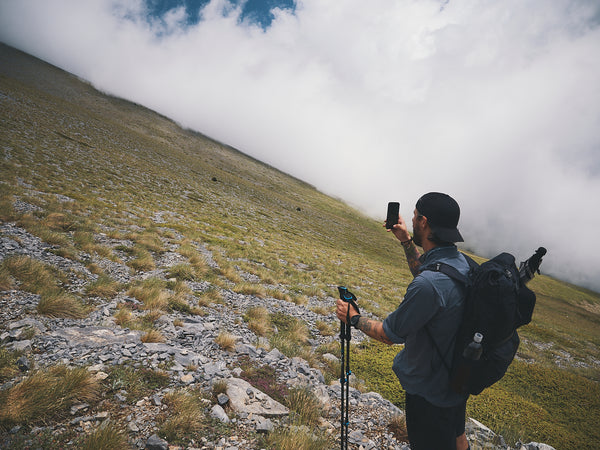Howdy, Huckleberry here and in today’s class I’m going to be rambling about two of my personal favorite subjects, hiking your own damn hike and photography. We live in a golden age of camera technology, the options are endless and readily available.
We all want to be able to look back on our experiences and have something to physically reflect on, instead of relying on hazy memories. Taking photography equipment on a hike is in the spirit of creation and recollection.
You need to ask yourself when selecting camera gear what kind of quality are you looking for, what are your goals with the equipment, will you be collecting memories, vlogging, or making cinematic narratives for your up and coming youtube channel. Figuring that out will be crucial when picking out your camera for hiking.
SMART PHONE

Over the years I’ve had to remind myself that “the best camera is the one you have”. I do not need to buy as much camera gear as I have and continually do (help). With that in mind, your smart phone is a fantastic option for taking photos and even videos of your hike.
The iPhone is responsible for the most amount of pictures on the internet. SecondChance filmed his PCT hike with his iPhone XS, and it continues to serve him well with his approach to vlogging his adventure. You don’t have to stick to Apple, there are lots of other great cameras on Android phones, like the Google Pixel or a Samsung Galaxy S-whatever-they’re-up-to-now.
Going this route is probably the lightest and simplest set up (stay ultralight, am I right?). You’ll have your phone anyways, so let’s just double-purpose it.
POINT & SHOOT
A step up past smartphones and a common choice amongst a lot of hikers. I personally own a weather-sealed point & shoot that I use as a general walkabout camera, that also comes on hikes. There are a lot of point and shoots on the market, so you have options here.
You can shell out the big bucks for a camera like the SonyRX100, which is what Bigfoot used to film the TGOC in 2019. The quality of these newer generation point and shoots is fantastic, so you’re really getting a lot of picture/video quality for a minor weight penalty.
Another option is something like Canon G7x mk ii, which Darwin used to film his entire PCT thru-hike in 2018. If those cameras seem a little pricey, there are also a lot of great used options on websites like Adorama or B&H. The little camera I use only ran me $70 for a high quality point & shoot that retailed at $300-$400 when brand new.
ACTION CAMERAS
I know I’m usually all about hiking your own hike and doing your own thing, but I personally don’t like action cameras. I’m not a fan of ultra wide focal lengths and the fisheye effect, it just doesn’t do anything for me.
My irrational bias aside, these cameras are still a great option if you’re looking to do some videos where you’re taking in all of the sights, and are concerned about your equipment getting wet. Most action cameras are made to be waterproof, so you can get footage of tromping through pouring rain just like you’ve always wanted.
Naturally the GoPro in its various iterations is a solid option, but there are other brands out there that make decent alternatives, like Sony’s action cameras. DJI also makes a few interesting options, like the Osmo Pocket, which is pretty perfect for vlogging because it has a built-in gimbal. You can see some footage from an Osmo Pocket over on Detail’s personal channel, during his hike in Greece.

MIRRORLESS
Mirrorless cameras offer the highest quality at the lowest weight (sorry DSLRs, we’re not gonna talk about you today). With a mirrorless camera, you get the option of having interchangeable lenses.
There are several great brands of mirrorless cameras out there, with a variety of sensor sizes, features, and optional add-ons. Going on about that would be an article of its own, so I’m just going to briefly touch on some of the options out there.
Sony has a smorgasbord of mirrorless cameras available. Chris Smead of Outmersive films uses Sony's a6000 series and a7 series to make his movies.
Then you have the Panasonic Lumix cameras, that produce amazing footage and images. Neemor uses a GH5 to great effect with his videos.
Another brand is Olympus, and our friend Nil of Deux Pas ver L’Autre uses his Olympus mirrorless camera for all of their photos and videos of their trek across Europe.

Next, you have to think about your lens selection. A nice zoom lens will give you more versatility, having a range of focal lengths to zoom in and out as desired. Zoom lenses are a bit heavier, so you’ll have to balance that out to your liking.
Another type of lens choice is a fixed focal length or prime lens, it only has a single focal length so if you want to zoom in and out, you’ll have to rely on your good ol’ foot zoom (walking).
I personally prefer prime lenses, because they’re lighter, simpler, and put a limitation on what you’re able to do, so you’re forced to be more creative with your composition. As an example Panda uses his Sony A7 with a 35mm lens for his trail videos.
CONCLUSION
So what kind of quality are you looking for? If you’re just looking to capture some memories (please print or backup your photos), your phone or a lower priced point and shoot will suffice.
But if you’re looking to go the extra mile and start working on the next cinematic trail documentary, then you’re going to want to dive into the creative options of a mirrorless system. Personally I use a small mirrorless micro 4/3rds camera with a 25mm prime lens, because it fits my personal approach to photography on and off trail.


